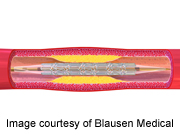
THURSDAY, Oct. 18 (HealthDay News) — Risk factors for heart disease — such as being overweight, having high cholesterol levels and smoking — are common in patients who undergo angioplasty and stent procedures to open blocked coronary arteries, a large new study finds.
Researchers looked at data from nearly 2 million patients who underwent heart catheterization procedures at nearly 1,500 facilities in the United States between Jan. 1, 2010, and June 30, 2011.
In cardiac catheterization, a long, thin, flexible tube (catheter) is inserted into a blood vessel and threaded to the heart. Through the catheter, doctors can conduct diagnostic tests and treatments on the heart.
About 1.1 million patients in the study underwent diagnostic cardiac catheterization and more than 940,000 underwent angioplasty and stenting, known as percutaneous coronary intervention.
Of the patients who had such intervention, nearly 80 percent were overweight, including 43 percent who were obese. Other risk factors for heart disease also were common. Eighty percent of patients had high blood cholesterol levels and 82 percent had high blood pressure. Nearly 28 percent of patients were current or recent smokers.
The study also found that 70 percent of patients who underwent procedures had heart attacks or other acute symptoms. About 18 percent had stable angina and 12 percent had either atypical symptoms or no angina.
Among patients who were suffering a severe heart attack and arrived at a hospital capable of performing angioplasty, the average time from arrival to treatment was 64.5 minutes. For patients who had to be transferred to another hospital, the average time from arrival at the first hospital to treatment was 121 minutes.
Cardiac catheterization was conducted through an artery in the thigh in just over 90 percent of procedures, rather than through an artery in the wrist.
Low-volume facilities (those that conduct fewer than 200 of these procedures per year) accounted for only 4 percent of the total number of percutaneous coronary interventions during the study period.
The findings appear online and in the Nov. 13 print issue of the Journal of the American College of Cardiology.
“These data will be of interest to the cardiovascular community because they show us where we are and where we can find opportunities for quality improvement,” lead author Dr. Gregory Dehmer said in a journal news release.
More information
The American College of Radiology/Radiological Society of North America has more about angioplasty and stenting.

